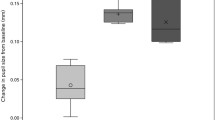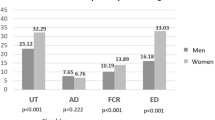Abstract
Background
Laparoscopic surgery may be kinder to the patient, but it is more demanding on the surgeon. Fixed trocar positions often require the surgeon to work with instruments at awkward angles to their body. We studied the effect of horizontal and vertical laparoscopic instrument working angle on the surgeon’s thumb, forearm, and shoulder muscle work.
Methods
Electronyographic (EMG) signals were collected from the thenar compartment (TH), flexor digitorum superficialis (FDS), and deltoid (DEL) muscles of the dominant arm of eight surgeons while they were closing a standard pistol-grip disposable laparoscopic grasper against a fixed resistance of 3 N. With the aid of a special testing bench, the instruments’ position was randomly changed among 15°, 45°, and 75° of horizontal angulation relative to the surgeons’ sagital plane, and 15°, 45°, and 75° degrees of vertical angulation relative to a horizontal plane. EMG signals were rectified and smoothed using analogue circuitry and digitally sampled at 10 Hz using a National Instruments DAQCard-700 connected to a Macintosh PowerBook 5300c running LabVIEW software. Statistical analysis was carried out by analysis of variance (ANOVA).
Results
The effects of vertical and horizontal working angles on the muscle effort were as follows: TH (horizontal, N.S.; vertical, N.S.), FDS (horizontal, p<0.001; vertical, N.S.), and DEL (horizontal, p<0.001; vertical, p<0.01).
Conclusion
These results suggest that working with laparoscopic instruments at a horizontal angle of >45° to the surgeon’s sagital plane significantly increases the workload of the flexor digitorium superficialis and deltoid muscles. The deltoid muscle is also adversely affected by vertical angulation of the instrument. The instrument working angle has no effect on the thenar muscles. Whenever possible, laparoscopic surgeons should strive to place their instruments and trocars so as to minimize extreme horizontal or vertical displacement of their hands away from a resting position of comfort.
Similar content being viewed by others
References
Berguer R, Forkey D, Smith WD (2001) Ergonomic problems associated with laparoscopic instruments. Surg Endosc 13: 466–468
Berguer R, Remler M, Beckley D (1997) Laparoscopic instruments cause increased forearm fatigue: a subjective and objective comparison of open and laparoscopic techniques. Min Invas Ther Allied Technol 6: 36–40
Bernard B (ed) (1997) Musculoskeletal disorder and workplace factors: a critical review of epidemiologic evidence for work-related musculoskeletal disorders of the neck, upper extremity, and low back. DHHS (NIOSH) publication no. 97–141. US Government Printing Office, Washington (DC)
Gerber S (1998). A comparative study of forces involved with manipulation of standard and laparoscopic surgical instruments [thesis]. Biomedical Engineering Program, California State University Sacramento (CA), 75 pp
Hanna GB, Shimi S, Cuschieri A (1997) Optimal port locations for endoscopic intracorporeal knotting. Surg Endosc 11: 397–401
Johnson SL (1993) Ergonomic hand tool design. Hand Clin 9: 299–311
Patkin M, Isabel L (1995) Ergonomics, engineering and surgery of endosurgical dissection. J R Coll Surg Edinb 40: 120–132
Tendik F, Jennings RW, Tharp G, Stark L (1993) Sensing and manipulation problems in endoscopic surgery: experiment, analysis, and observations. Presence 2: 66–80
Author information
Authors and Affiliations
Additional information
Online publication: 12 June 2001
Rights and permissions
About this article
Cite this article
Berguer, R., Forkey, D.L. & Smith, W.D. The effect of laparoscopic instrument working angle on surgeons’ upper extremity workload. Surg Endosc 15, 1027–1029 (2001). https://doi.org/10.1007/s00464-001-0019-1
Received:
Accepted:
Issue Date:
DOI: https://doi.org/10.1007/s00464-001-0019-1




